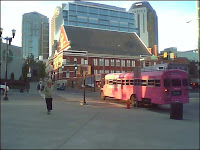 Red powder, really. Under our nails, coating our feet, dusting our hair and making all four of us, black dogs included, into strawberry blondes. We dust off each time before stepping into the van. The wind has worn Oklahoma sandstone--as illustrated by one of the famous rose rocks, above, given to us by Judith's cousin Judy--into such a fine powder it is difficult to believe anyone ever tried to farm here. But they did: they famously busted open the land with the plow, trying to plant as many fields of wheat as they could, even as the economic cycles and over supply forced wheat prices down. As prices went down, they . . . planted more. Not dissimilarly from corn today, which is another whole story and one told best by Michael Pollan's Omnivore's Dilemma. And the more they busted open the red powder land, the more it blew, resulting in a red dirt dustball the likes of which my generation is lucky to have never seen.
Red powder, really. Under our nails, coating our feet, dusting our hair and making all four of us, black dogs included, into strawberry blondes. We dust off each time before stepping into the van. The wind has worn Oklahoma sandstone--as illustrated by one of the famous rose rocks, above, given to us by Judith's cousin Judy--into such a fine powder it is difficult to believe anyone ever tried to farm here. But they did: they famously busted open the land with the plow, trying to plant as many fields of wheat as they could, even as the economic cycles and over supply forced wheat prices down. As prices went down, they . . . planted more. Not dissimilarly from corn today, which is another whole story and one told best by Michael Pollan's Omnivore's Dilemma. And the more they busted open the red powder land, the more it blew, resulting in a red dirt dustball the likes of which my generation is lucky to have never seen.But Judith's family did: they were homesteaders and sheep herders and her mother remembered moving around in a wagon until they landed finally in Oklahoma City. Shown to the right are JJ and her cousin Rodger, seconds before he jets off to Germany.

I didn't have time in my last post to talk about Rodger's wife, Judy (Oklahoma is populated by Ralph's and Judy's); she has been a journalist with the Tulsa Globe for almost 40 years, and is currently their book editor. Despite its empty downtown, Tulsa--called by Rodger and others an "eastern city" for the way it was developed by eastern oil men--Tulsa is a thriving intellectual center in OK, and Judy, proud of her city, is a great example of that. I'm always awed and proud to meet anyone who has been a daily journalist for 40 years . . .
Oklahoma City, the state capital and unlike Tulsa, is what is known as a "cow town." Populated and run by cowboys, it has a "western spirit" and design unlike Tulsa. This is where JJ grew up, in a small neighborhood just outside downtown with her mother's parents, whom she called Nanny and Dada.

Oklahoma is celebrating its centennial: it is very nearly the youngest state in the nation. Centennial sounds funny to my eastern ears, educated as they were at a college founded in 1796 . . . to prepare, the Oklahoma legislature raised the money to finish building the capital building, completing its rotunda in 2002! We use it as a landmark as we drive downtown. Downtown to the Oklahoma City National Monument: other than the World Trade Centers, this is the only other place in the U.S. where a bomb has killed significant numbers of U.S. citizens: and this bomb was created and detonated by a U.S. citizen himself.

The memorial, designed by a German artist, is eerily beautiful: the street that used to run past the Alfred J. Murragh Federal Building, the block used by Timothy McVeigh to drive his van into, transformed into a reflecting pool. Chairs for each of the 168 killed in the bombing. McVeigh did not like the way in which federal agents handled David Koresh's radical Christian sect at Waco, TX (and who did, since federal agents ended up firebombing the place) and decided to seek retribution. It's really a shame the Bible has that line in there about "an eye for an eye." The Christianity with which I was raised was one of forgiveness, not vengeance: the Christianity I know doesn't support putting more of our citizens in jail than does any other nation, nor does it support the death penalty. But that's just the point: everyone has their own reading of the Bible, and so many of these readings are not about love and compassion, grace and forgiveness; so many of them are simply deadly.
So we travel on, toward Texas and New Mexico, asking: what is the "western spirit?"





